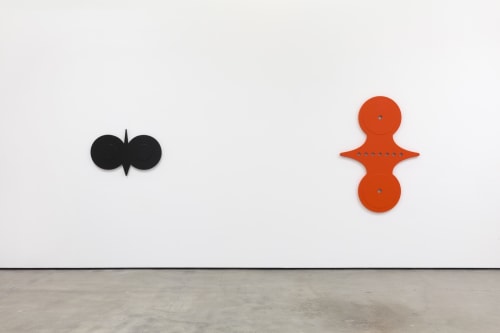Two months after the shutdown of California’s nonessential businesses, GalleryPlatform.LA launches on Friday, providing an online space to browse art as galleries remain closed. Each week, the platform will feature a different group of 10 exhibitors, starting with a formidable inaugural lineup: previously unseen works by celebrated L.A. sculptor Charles Ray, presented by Matthew Marks; a supernatural sampling of Jeffrey Deitch’s prematurely closed group show, “All of Them Witches”; Mathieu Malouf paintings presented by Jenny’s, and more. Various Small Fires chose paintings of large-scale disasters by 80-year-old artist Jessie Homer French, whose self-taught, desert-based practice resonates with our current climate, according to gallery director Sara Hantman: “In many ways, she’s always been a bit of a self-isolationist.”
This group show is the first by the newly minted Gallery Association Los Angeles, or GALA, a group of 60 L.A. galleries who have organized in response to the tumult of the lockdown. The business of selling art, like almost every other, has been struggling: A quarter of gallerists polled by the L.A. Times reported that they were in danger of never reopening. And in the global market, Swiss mega dealer Dominique Lévy, owner of galleries in London, Zurich, New York, and Hong Kong, described the severity of the situation plainly in her interview with CNN: “Business, I believe, is down by 90 percent, if not 95 percent.”
GalleryPlatform.LA and other digital initiatives like it aim to reconnect galleries with their estranged audience amid canceled exhibitions and art fairs, which account for an increasingly large share of business. GALA members, however, are keeping their commercial expectations measured. “I don’t think [GalleryPlatform.LA] solves the fact that we’re not having art fairs,” says Regen Projects’s Shaun Caley Regen, as the age-old traditions of art dealing haven’t quite found their place in the world of online retail.
Following the online viewing rooms that Art Basel Hong Kong and Frieze New York mounted in lieu of physical gatherings this year, both collectors and dealers expressed their disappointment in clunky web design and lackluster sales.
“The operations and transactions of the art world run on a kind of in-person charisma,” explains GALA member Olivia Barrett of Chateau Shatto. Despite successful runs in David Zwirner and Frieze New York’s online platforms, her email exchanges with new collectors lacked that “sense of spontaneity, chemistry, and social animation” of an in-person meeting. And even as David Zwirner and Hauser & Wirth dabble in new extended reality and augmented reality experiences, gallerists across the board will agree that the vast majority of art loses something when it’s put on screen.
In the absence of face-to-face conversations, GalleryPlatform.LA strives to build a more 360-degree experience for its visitors, engaging in robust, “personality-driven” storytelling in the form of video access to artists’ studios and collectors’ homes, plus archival materials that reflect and celebrate L.A.’s “incredibly rich history,” says Sprüth Magers director Marta Fontolan. As she maps out the editorial content as part of the platform’s operating committee, she says, “I think art is best experienced in real life. But the internet, thank God for it. It’s the only means of communication we have right now.”
Foregoing the complications of an elaborate interface, GalleryPlatform.LA at its core is a standard website that includes gallery guides and exhibition schedules for all 60 of its members. But “I don't think it can be understated, the symbolic value of L.A. galleries weathering this crisis together,” says Commonwealth & Council’s Kibum Kim. The simple gesture of creating a single destination to find all of its members—from global empires like Gagosian and Hauser & Wirth, whose L.A. locations are just one of a dozen or so worldwide, to younger, homegrown programs like Inglewood’s Residency Art—speaks to the project’s long-term mission toward community solidarity, and the consolidation of audiences and support for one another’s artists.
For gallerists around the world, the pandemic has been a forced point of inflection “almost as if Corona rushed us through a process,” Fontolan says, “the evolution of the way that we communicate, work, sell and talk.”
The welcome break from an increasingly unsustainable art fair schedule has also given Kim the time and space to reorient his focus on home, “to reevaluate and recommit to what I love about art and the business,” he says. “For me, Gallery Association will be the most lasting, powerful thing to come out of this.”
